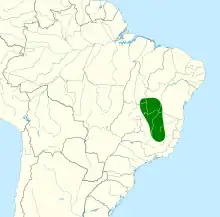Diamantina sabrewing
The Diamantina sabrewing (Campylopterus diamantinensis) is a Near-threatened species of hummingbird in the "emeralds", tribe Trochilini of subfamily Trochilinae. It is endemic to southeastern Brazil.[3][4]
| Diamantina sabrewing | |
|---|---|
| Scientific classification | |
| Domain: | Eukaryota |
| Kingdom: | Animalia |
| Phylum: | Chordata |
| Clade: | Dinosauria |
| Class: | Aves |
| Clade: | Strisores |
| Order: | Apodiformes |
| Family: | Trochilidae |
| Genus: | Campylopterus |
| Species: | C. diamantinensis |
| Binomial name | |
| Campylopterus diamantinensis Ruschi, 1963 | |
 | |
Taxonomy and systematics
The Diamantina sabrewing was formerly considered to be a subspecies of the grey-breasted sabrewing (Campylopterus largipennis). In a 2017 paper Lopes et al. provided convincing evidence that it deserved species status.[5] Starting in 2020 the South American Classification Committee of the American Ornithological Society and worldwide taxonomic systems agreed, recognizing the Diamantina sabrewing. It is monotypic.[6][3][7][4]
Description
The Diamantina sabrewing is a large hummingbird, about 13.4 cm (5.3 in) long. Males weigh about 8.5 g (0.30 oz) and females 8.0 g (0.28 oz). The sexes have almost identical plumage including a white spot behind the eye. Their bill is long and slightly decurved; the maxilla is black and the mandible whitish with a brownish tip. Male's upperparts are dark grass green with a darker crown and their underparts dark gray. Their tail's central two pairs of feathers are metallic bronze-green. The other three pairs have bright bronze-green bases that grades through dark olive gray to a wide white tip. The female differs only by being a slightly duller green.[8]
Distribution and habitat
The Diamantina sabrewing is found only in the Espinhaço Range of southeastern Brazil's Minas Gerais state. It inhabits forested streams and ravines in campos rupestre, a high elevation, dry, fire-prone biome between 1,000 and 2,000 m (3,300 and 6,600 ft). The type locality is Córrego das Pedras in the municipality of Diamantina.[5][8]
Behavior
Movement
The Diamantina sabrewing's movements, if any, have not been documented.[8]
Feeding
The Diamantina sabrewing's foraging strategy and diet are not known but are assumed to be similar to those of its former "parent" the grey-breasted sabrewing.[8]
Vocalization
The Diamantina sabrewing's vocalizations are very poorly known. As of mid-2022 xeno-canto has no recordings and the Cornell Lab of Ornithology's Macaulay Library only two.[8] The species' original description noted that its alarm call is "a strong, rapidly repeated single note: ché, ché, ché, ché, ché, ché."[9]
Status
The IUCN has assessed the Diamantina sabrewing as Near Threatened. It has a very small range and its population size is unknown and believed to be decreasing. Its already restricted habitat is projected to further decrease in area due to climate change.[1] Its habitat "is not presently experiencing major direct human disturbance" and part of it is protected in two national parks.[8]
References
- BirdLife International (2021). "Diamantina Sabrewing Campylopterus diamantinensis". IUCN Red List of Threatened Species. 2021: e.T200278757A200746437. Retrieved 7 August 2022.
- "Appendices | CITES". cites.org. Retrieved 2022-01-14.
- Gill, F.; Donsker, D.; Rasmussen, P., eds. (January 2022). "Hummingbirds". IOC World Bird List. v 12.1. Retrieved January 15, 2022.
- HBW and BirdLife International (2021) Handbook of the Birds of the World and BirdLife International digital checklist of the birds of the world. Version 6. Available at: http://datazone.birdlife.org/userfiles/file/Species/Taxonomy/HBW-BirdLife_Checklist_v6_Dec21.zip retrieved August 7, 2022
- Lopes, Leonardo; Ferreira de Vasconcelos, Marcelo; Gonzaga, Luiz (2017). "A cryptic new species of hummingbird of the Campylopterus largipennis complex (Aves: Trochilidae)". Zootaxa. 4268 (1): 1–33. doi:10.11646/zootaxa.4268.1.1. PMID 28610380.
- Remsen, J. V., Jr., J. I. Areta, E. Bonaccorso, S. Claramunt, A. Jaramillo, D. F. Lane, J. F. Pacheco, M. B. Robbins, F. G. Stiles, and K. J. Zimmer. Version 24 July 2022. A classification of the bird species of South America. American Ornithological Society. https://www.museum.lsu.edu/~Remsen/SACCBaseline.htm retrieved July 24, 2022
- Clements, J. F., T. S. Schulenberg, M. J. Iliff, S. M. Billerman, T. A. Fredericks, J. A. Gerbracht, D. Lepage, B. L. Sullivan, and C. L. Wood. 2021. The eBird/Clements checklist of Birds of the World: v2021. Downloaded from https://www.birds.cornell.edu/clementschecklist/download/ Retrieved August 25, 2021
- Greeney, H. F. (2021). Diamantina Sabrewing (Campylopterus diamantinensis), version 1.0. In Birds of the World (H. F. Greeney, Editor). Cornell Lab of Ornithology, Ithaca, NY, USA. https://doi.org/10.2173/bow.gybsab5.01 retrieved August 7, 2022
- Ruschi, A. (1963). Um novo representante de Campylopterus (Campylopterus largipennis diamantinensis), da região de Diamantina, no Estado de Minas Gerais. Bol. Mus. Biol. Mello Leitão, Biol. 39: 1-9. In Portuguese with English summary.
